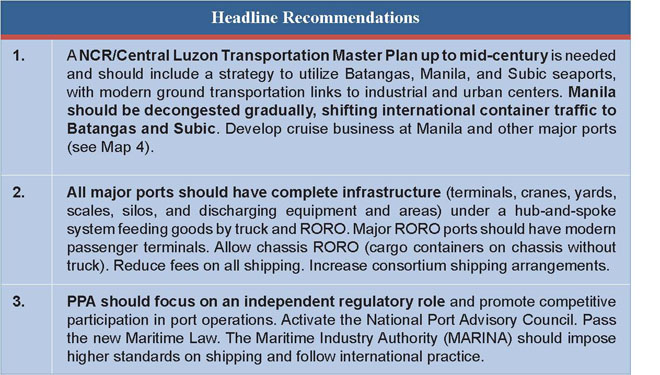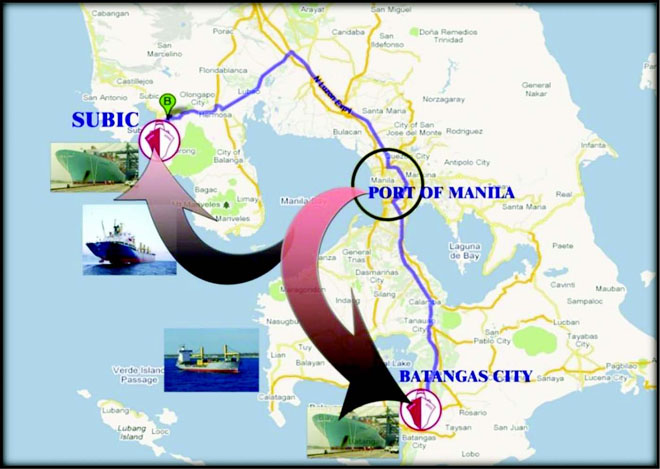
Recommendations (20):
A. The recommended NCR/Central Luzon Transportation Master Plan should include a strategy for future utilization and development, until mid-century, of the major international seaports in Central Luzon, the Visayas, and Mindanao. The plan should include ground transport infrastructure linking the seaports to airports and cities. The plan should set the capacity of ports in relation to the adjacent road networks and to overall domestic and international shipping demand. It should also include a seamless, integrated inter-modal transport system. (Medium-term action PPA, MARINA, DOTC, DPWH, NEDA, and private sector)
B. A hub-and-spoke system is ideal with major ports highly developed for larger ships with cargoes delivered from smaller production centers by truck or small RORO. (Long-term action PPA and DOTC)
C. Major ports should include all needed infrastructure including container terminals, cranes, truck marshalling areas, and weighing scales, which are not present at many ports.101 (Medium-term PPA, DOTC, and private sector)
D. Major RORO ports should have modern passenger terminals with connected bus terminals, security systems, and berthing spaces with good road access.102 (Medium-term action PPA and DOTC)
_____________
101 A ship’s crane adds as much as 30% to capital cost of the vessel and increases operating costs. Shipping companies in the Philippines usually have to provide infrastructure that in other countries is provided by the port operator. Some ports (e.g. Iloilo) have draft limitations preventing larger ships from servicing them.
102 Currently, shipping companies at many ports have to provide passenger terminals and luggage screening equipment and berthing spaces may be shared with freighters.
|
|
E. Port infrastructure should also include facilities to accommodate bulk and break bulk cargoes (e.g. silos, discharging equipment, and discharging areas).103 (Long-term action PPA, DOTC, and private sector)
F. Adopt a firm policy to gradually shift international container shipment volume from Manila (South Harbor and MICT) to Batangas and Subic.104 (Immediate action PPA and DOTC)
Map 4: Decongesting the Port of Manila

G. As part of the recommended Master Plan, PPA should take the lead in a transport study to identify the ideal capacity ports should have in relation to its adjacent road network to avoid and to reduce congestion. A cap on TEUs per port should be established, with cargo above the limit moved to other ports. The study should also plan for the development of an inter-modal system with rail, roads, and waterways. (Immediate action PPA, DOTC, MMDA, and private sector)
____________
103 Bulk wet services for oil distribution are privately owned and operated. Bulk dry and break bulk cargoes require separate facilities and discharge areas.
104 Manila South Harbor and MICT handles about 60% of the total Philippine international container shipment volume, while Batangas and Subic have very low volumes. When the Bangkok port in Thailand was overcrowded, congesting the city’s urban core, the new port of Laem Chabang was constructed in an area 90 minutes away from the city. To decongest the Bangkok port, a container volume limit of one million TEUs was enforced. Anything beyond that cap were required to pass through Laem Chabang.
|
|
H. Retain North Harbor as a domestic port, shift foreign cargoes to Batangas and Subic and make Manila a cruise port.105 This will decongest Manila and make it unnecessary to invest as much in road infrastructure for Manila port.106 There should be a timetable for implementation and incentives for shippers to move.107 Private port operators should creatively market the ports. (Immediate action PPA, DOTC, NEDA, SBMA, and private sector)
I. PPA should consider creating a private corporation to develop ports and privatize the ports through an IPO to create broad ownership.108 (Medium-term action PPA, DOF, and Congress)
J. Container shipping costs should be reduced by (a) eliminating the double charging of separate stevedoring and arrastre charges by rationalizing them into one cargo handling charge;109 and (b) no arrastre fee should be charged for RORO and LOLO which discharge directly onto the truck bed. (Immediate action PPA and DOTC)
K. PPA must find innovative ways to cut costs and increase revenue aside from continuously increasing fees, which make Philippine ports less competitive and adds to costs for cargo owners. (Immediate action PPA and DOTC)
L. Domestic shipping costs can also be reduced by the port modernization recommendations in B, C, D and E above.110
M. The practice of extorting illegal fees from truckers should be stopped by LGUs; lighted, safe and secure rest areas should be provided along the nautical highway. (Immediate action DPWH and DILG)
N. MARINA must have greater political will to impose higher standards on quality, safety, and environmental protection following international practices, which will help create a more mature and efficient Philippine shipping industry.111 (Immediate action MARINA, DOTC, and private sector)
_______________
105 Cruise ship operations in Southeast Asia and Southern China are increasing, with two international cruises already visiting Manila in the first quarter of 2010.
106 When the new Cavite coastal road is completed, cargo coming from the south could reach the Manila port through a tunnel under Roxas Boulevard. However, this proposal which was submitted to the DPWH in 2001 has not been acted on. DPWH and NEDA should undertake to study the proposed project if international cargo traffic stays at Manila. Also, a review of the truck ban in areas covered by the route of container trucks should take place when this project becomes final.
107 Challenges that need to be considered include: (1) existing contracts of PPA with ICTSI and ATI, (2) cooperation of the two port authorities – PPA for Batangas and Manila, and Subic Bay Metropolitan Authority (SBMA) for Subic, the later potentially gaining revenue from cargoes formerly handled at PPA ports, and (3) the needed road infrastructure (e.g. the additional two lanes of the STAR Tollway to Batangas should be completed as well as the road connection to the SLEX).
108 Creating competition among port operators has proven difficult because of low TEU volume and the perception that politics may overturn bid awards, as happened to one of Asia’s largest port operators which was awarded the operation of the Subic port in the early 1990s. Thus few foreign port operators have participated in biddings. Port development is expensive, with a container berth costing more than US$ 100 million. The low volume, even in Manila where there are two operators, seemed unlikely to attract interested competitors, but a third operator (a Metropacific joint venture with Harbor Center) for privatization of the North Harbor operation has been approved.
109 A single charge is the common practice in other countries, which do not make a distinction between land and vessel cargo handling.
110 A foreign ship at ICTSI discharges at 30 moves per hour compared to even 50 moves in other countries, while a ship using its own cranes can discharge at 7 TEUs per crane per hour. The many inefficiencies of port operations, inadequate road infrastructure resulting in truck bans, illegal fee collections, inadequate infrastructure at ports all combine to increase domestic operating costs.
111 Because of high operating costs, many older ships are brought into the Philippines but are more costly to run. BOI incentives for newer ships are usually not enough to outweigh these costs.
|
|
O. Amend the RORO policy to include chassis RORO as part of the service. (Immediate action PPA, MARINA, and DOTC)
P. Remove unnecessary (as well as unauthorized) fees affecting RORO traffic.112 (Immediate action DPWH, DOTC, and DILG)
Q. RORO bills of lading should be more transparent; currently they are prepared on ships and do not show port of origin, commodity, and value. (Immediate action MARINA and DOTC)
R. Cabotage restrictions require further discussion but should probably be eased through Consortium Shipping. The Philippine Inter-Island Shipping Association argues that, because almost every country imposes cabotage, the Philippines should as well. The counter-argument is that removing cabotage will increase competition, improve service and safety, and reduce domestic shipping costs for exporters and consumers. (Immediate action DOTC and private sector)
S. Pass and implement the new Marine Law, which came close to final passage in early 2010.113 The Marine Law addresses several areas intended to raise Philippine law to a level competitive with other flag states.114 (Immediate action DOTC, Congress, and private sector)
T. Solve a serious structural regulatory problem by separating the policy-making body from port operations. Create a National Port Advisory Council that would define the policies of the ports and put jurisdiction of all ports under the DOTC. (Immediate action DOTC and OP)

Airports and Seaports FGD Participants, Moderator and Secretariat Members
November 26, 2009
Joint Foreign Chambers of the Philippines
FOCUS GROUP DISCUSSION ON AIRPORTS AND SEAPORTS
___________________
112 Provinces where trucks pass through require their own stickers, each cost as much as PhP 1,000 per year. In some areas, illegal toll fees are collected by LTO, highway patrol, PNCC and Coast Guard causing delay and adding cost to operators.
113 The bill consolidates maritime functions into a single government agency. Currently, there are many agencies regulating the maritime industry. The bill also: shifts registry from income taxation into tonnage dues (following other neighboring countries); turns the maritime agency into a fiscally-independent authority (which will raise its revenues through the collection of tonnage dues); gives better salaries to technical experts; creates a Marine Transport Safety Board (an independent investigating body reporting to the president with joint prosecutorial powers with the Department of Justice (DOJ) and able to file charges in courts); and creates a GOCC to lend money to ship owners at an interest rate 3% below market.
As the largest supplier of seafarers, the Philippines has potential to develop its overseas shipping industry as a cross-trader but has been held back by a faulty mortgage law which has not been accepted by international banks. Future development of the industry depends on cross-trading because of limited domestic cargo and trade, although growth of mining exports could provide new opportunities.
114 These include: (a) ownership at 51%-49% for overseas shipping; (b) an annual tonnage tax instead of income tax because most flag states provides tax incentives; (c) correction of the faulty mortgage law to conform with international convention; (d) adoption of international safety and marine environment protection standards; and (e) other provisions that will put the country at par with other flag states.
|
|
|
|
|
|